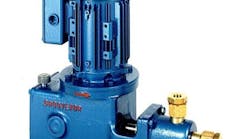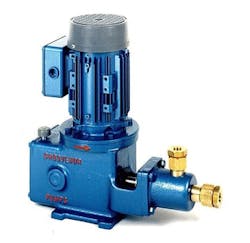Some processes require dosing a precise volume of liquid into another flow stream in a specified time period. A metering (or dosing) pump usually handles the task. The term “metering pump” refers to the service rather than the particular kind of pump used. These pumps are not suitable for injection of gases; however, they can inject a liquid into a gas stream.
Metering pumps typically must supply practically constant flow rates of liquids (when averaged over time) within a wide range of discharge (outlet) pressures. Manufacturers provide each of their models of metering pumps with a maximum discharge pressure rating. Because the pumps are positive displacement devices, they usually can generate required discharge pressure if the drivers provide enough power. Of course, selection also must ensure the pressure and temperature ratings and wetted pump materials are compatible with the application and type of liquid being pumped. Most metering pumps have a pump head and an electric motor (driver). The liquid goes through the pump head, entering through an inlet line and leaving through an outlet line.
Figure 1. A small gearbox powered by an electric motor drives this single-acting plunger pump. Source: Grosvenor Pumps.
This article focuses on piston and diaphragm pumps and presents practical guidelines on the selection and operation of these metering pumps in chemical processes.
The Basics
A metering pump is a positive-displacement dosing device with the ability to vary capacity manually or automatically, as process conditions require. It features a high level of repetitive accuracy and can pump a wide range of liquids, including acids, bases, corrosive fluids, viscous materials and slurries. The particular fluid often can pose challenges for engineering, fabrication, commissioning and operation.
Metering pumps generally handle applications demanding high accuracy but relatively low flow rates; they usually are medium- or high-pressure pumps. A computer, microprocessor or flow-proportioning device commonly controls the pump.
Reciprocating motion (often from a piston) usually creates the pumping action. The piston either directly contacts the process fluid or moves (via air or hydraulic fluid) a diaphragm between it and the fluid.
During the suction stroke, the piston moves out, creating a vacuum that pulls liquid into the pump cavity past an inlet check valve. During the discharge stroke, the inlet valve closes and the piston moves in, pushing liquid through a now-open outlet check valve. These alternating suction and discharge strokes repeat over and over to meter and deliver the liquid. Changing the stroke length or adjusting the cycle frequency varies the flow.
Other types of metering pumps, such as peristaltic and bellows ones, find use in special applications. In peristaltic pumps, motor-driven rollers travel along flexible tubing, compressing it to push forward a liquid inside. Bellows pumps move a bellows back and forth to displace liquid. However, piston and diaphragm pumps handle the bulk of metering duties, and so this article focuses on them.
Figure 2. This single-acting diaphragm pump uses corrosion-resistant plastics for wetted parts. Source: Grosvenor Pumps.
Piston Pumps
These positive-displacement devices can be designed to pump at practically constant flow rates (averaged over time) against a wide range of discharge pressures. Such pumps produce pressures to 700 Barg; special types can achieve pressure above 1,000 Barg. Figure 1 shows a single-acting piston pump.
Generally in such pumps, a piston (sometimes called plunger), typically cylindrical, goes in and out of a correspondingly shaped chamber in the pump head. Packing around the piston or a doughnut-shaped seal with a toroid-shaped sphincter-like spring inside that compresses the seal around the piston usually holds the fluid pressure when the piston slides in and out and makes the pump leak-tight. The packing or seals can wear out after prolonged use but can be replaced. The potential for wear and subsequent leaks makes piston pumps a bad choice for abrasive fluids.
A single-piston pump (Figure 1) delivers liquid to the outlet only during the discharge stroke. If the piston’s suction and discharge strokes occur at the same speed, liquid is metered out half the time the pump is working; so, the overall metering rate averaged over time equals half the average flow rate during the discharge stroke. Some single-piston pumps feature a constant slow piston motion for discharge and a quick retract motion for refilling the pump head. For such devices, the overall metering rate practically equals the pumping rate during the discharge stroke.
Diaphragm Pumps
These pumps use reciprocating movement to pulse a flexible membrane — usually made of rubber or a fluoropolymer or other thermoplastic — to displace liquid with each stroke. The liquid doesn’t penetrate through the diaphragm. Diaphragm pumps usually possess good suction lift characteristics. The devices produce pressures to 100 Barg; special variants can achieve higher pressures. These pumps usually require no seals; this suits them for handling abrasives and slurries. In addition, they are a good choice for dangerous, toxic or noxious liquids because they obviate issues of leakage through seals or packing. They also have good self-priming capabilities and dry-running characteristics. Some units boast efficiencies that reach as high as around 97%.
Diaphragm pumps often are electric motor driven (such as the one shown in Figure 2) but pneumatic- and hydraulic-powered units also are available. The pumps can be categorized by what’s on each side of the membrane:
• Process fluid on one side and compressed air or hydraulic fluid on the other. Such air-operated or hydraulic pumps can be used in areas where electrical devices aren’t suitable or would be very expensive because of explosion-proof or electrical-area-classification requirements; in other words, they are popular for many applications to avoid area classification problems or intermittent electric power availability issues. They are more compact and lighter than other designs.
• Process fluid on one side and ambient air on the other. Diaphragm flexing occurs due to the action of a crank, geared motor drive, lever or other mechanism. These pumps usually are more energy efficient than other designs. One reason is because the drive system doesn’t require expensive compressed air or hydraulic oil. In addition, they can be tailored to the needs of the specific application.
Such pumps most often are electro-mechanical double-acting designs. In these, the integral metal core of each membrane is completely covered by the membrane material on its fluid pumping side, minimizing the possibility of fluid contamination. The smooth mechanically controlled linear drive of the membranes can ensure low-shear transfer at precisely controlled rates even when viscosity, pressure or other operating parameters change. A variable frequency drive can enable easy adjustment of flow rates. An external electrical control device such as a pressure switch can limit maximum discharge pressure if necessary.
• Process fluid on both sides. These pumps employ one or more unsealed diaphragms. Flexing of the diaphragm(s) causes the volume to change. These devices rarely are used.
Operating Issues
Often, a metering pump can exceed its pressure rating if it continues running after a downstream valve closes or line blockage occurs. For this reason, it is good practice to place a pressure relief valve ahead of the valve to prevent over-pressuring the tubing or piping line. The relief valve setting should be below the maximum pressure rating of the tubing, piping or downstream component with the lowest rating.
Gas bubbles entering a pump head can cause problems. The compression motion compresses the gas but doesn’t necessarily drive it out of the pump head. In such cases, the pump may stop discharging liquid even though mechanically it’s going through the motions — in reality, it’s just repeatedly compressing and decompressing the bubbles. Preventing this type of “vapor lock” often calls for degassing of some solvents and other liquids before pumping.
If the outlet pressure is lower than the inlet pressure and remains that way in spite of the pumping, then this pressure difference opens both check valves simultaneously; liquid flows through the pump head uncontrollably. This can happen whether or not the pump is running. Placing a correctly rated positive-pressure-differential check valve downstream of the pump avoids the issue. Such a valve only will open if the minimum rated pressure differential across the valve is exceeded, which is a possibility with most high-pressure metering pumps.
Valves are a common source of problems; diaphragms top the issues for that type of pump. Metering pumps usually require maintenance to valves and diaphragms approximately every six months to one year.





